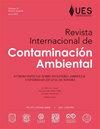实验室试验评价柴油机尾气污染物对毛细管蒂兰和西花Ramalina celastri的影响
IF 0.4
4区 环境科学与生态学
Q4 ENVIRONMENTAL SCIENCES
引用次数: 0
摘要
与交通有关的空气污染是城市地区最相关的环境问题之一。几种隐球菌(即地衣和苔藓)和维管物种已被用于监测城市空气污染,因为它们可以同时以低成本评估大量采样点的空气质量。在大城市,车辆排放往往是空气污染的主要来源,与住宅能源(用于烹饪和供暖)、工业、发电和垃圾焚烧一样。这些城市环境中的生物监测器暴露在污染物的混合物中,很难确定哪种污染物对生物体的损害最大。然而,分析汽车尾气排放污染物影响的研究很少,而且在阿根廷最常用的生物监测物种的特殊情况下,迄今为止还没有对它们如何受到汽车尾气影响进行分析。因此,本工作的目的是分析在实验室条件下暴露于柴油废气中的西花Ramalina celastri的理化参数(色素含量、促氧化产物和硫积累)的变化,以及Tillandsia capillaris的重金属积累。在暴露20分钟和在暴露室中持续48小时后,观察到青藤光合器的强烈损伤以及毛细管毛中的金属浓度。结果表明,不仅颗粒和金属会对这两种众所周知的生物监测器造成损害,而且这些污染物与大气中形成不同二次污染物的其他成分的相互作用,再加上较长的暴露时间,可能会对它们造成最高程度的损害。本文章由计算机程序翻译,如有差异,请以英文原文为准。
Assessment of diesel exhaust pollutants effects in Tillandsia capillaris and Ramalina celastri by laboratory trials
Traffic-related air pollution is one of the most relevant environmental problems in urban areas. Several cryptogams (i.e., lichens and mosses) and vascular species have been employed to monitor urban air pollution since they allow the assessment of air quality in a large number of sampling sites simultaneously at low cost. In large urban cities, vehicle emissions are frequently the major source of air pollution along with residential energy (for cooking and heating), industry, power generation, and waste incineration. Biomonitors in these urban environments are exposed to a mixture of pollutants making it difficult to identify which pollutant causes the greatest damage to organisms. However, studies that analyze the effect of pollutants emitted by vehicle exhaust are scarce and in the particular case of the most used biomonitor species in Argentina, no analysis of how they are affected by vehicle emissions has been carried out so far. So, the aim of this work was to analyze changes in physiochemical parameters (pigment content, pro-oxidant products, and sulfur accumulation) in Ramalina celastri, and heavy metal accumulation in Tillandsia capillaris, exposed to diesel exhausts under laboratory conditions. A strong damage in the photosynthetic apparatus of R. celastri was observed as well as metal concentration in T. capillaris after 20 min of exposure and 48 h of permanence in the exposure chambers. The results indicate that not only the particles and metals cause damage to these two well-known biomonitors, but the interaction of these pollutants with other components of the atmosphere that form different secondary pollutants, together with a longer exposure time, could cause the highest level of damage in them.
求助全文
通过发布文献求助,成功后即可免费获取论文全文。
去求助
来源期刊

Revista Internacional De Contaminacion Ambiental
ENVIRONMENTAL SCIENCES-
CiteScore
0.90
自引率
16.70%
发文量
59
期刊介绍:
En esta revista se aceptan para su publicación trabajos originales y de revisión sobre aspectos físicos y químicos de la contaminación, investigaciones sobre la distribución y los efectos biológicos y ecológicos de los contaminantes; así como sobre tecnología e implementación de nuevas técnicas para su medida y control; también son aceptados estudios sociológicos, económicos y legales acerca del tema. Se publicarán los escritos que mediante arbitraje de especialistas y a juicio del Consejo Editorial tengan el nivel y la calidad adecuados para ello y su contenido será responsabilidad única de los autores. La Revista Internacional de Contaminación Ambiental es de periodicidad trimestral y se publica los días 1 de febrero, mayo, agosto y noviembre.
 求助内容:
求助内容: 应助结果提醒方式:
应助结果提醒方式:


